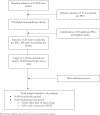Determinants of outpatient healthcare-seeking behaviors among the rural poor affected by chronic conditions in India: a population-based cross-sectional study in seven states
- PMID: 40223762
- PMCID: PMC11998304
- DOI: 10.1080/16549716.2025.2480413
Determinants of outpatient healthcare-seeking behaviors among the rural poor affected by chronic conditions in India: a population-based cross-sectional study in seven states
Abstract
Background: A rising burden of chronic non-communicable diseases (CNCDs) increases demand for outpatient healthcare. Yet, evidence on preferences and barriers to healthcare services for India's most disadvantaged population, the target of India's largest public health insurance scheme (PM-JAY), is lacking.
Objective: We explore determinants of outpatient healthcare-seeking behavior among PM-JAY eligible individuals with CNCDs in rural areas of seven states.
Methods: Using cross-sectional data from a household survey (conducted between November 2019 and March 2020), we employed multilevel multinomial logistic regression to identify factors associated with seeking care from informal (home treatment, pharmacies, traditional healers), formal public, or formal private providers, compared with no care. Anderson's behavioral model informed the selection of independent variables.
Results: Of 51,820 individuals, 5,061 (9.8%) reported a chronic condition. Despite their disease, 1,168 (23.1%) reported not using regular outpatient care. Another 2,421 individuals (48.0%) used formal private, 922 (18.3%) used formal public, and 535 (10.6%) used informal care. Predictors of formal private care were higher socioeconomic status (RRR = 2.441, 95% CI [1.61, 3.70]) and health insurance coverage (RRR = 1.478, 95% CI [1.12, 1.95]). Residents of Tamil Nadu, Kerala, and Gujarat were more likely to use formal public care (RRR = 23.915, 95% CI [9.01, 63.44]). Suffering from Major CNCDs or experiencing limitations in daily activities increased the probability of using healthcare across all options.
Conclusion: Future research should explore the reasons for non-utilization of chronic care and the preference for private providers. Policies to enhance public healthcare utilization and expand insurance for outpatient care could improve access and reduce health inequities.
Keywords: Health services; India; Quality of Care for Chronic Conditions; low-and-middle-income countries; multinomial logistic regression; non-communicable diseases; primary health care; private sector; public sector; socio-economic; treatment.
Plain language summary
Main findings: Among India's rural populations, outpatient health service use for chronic non-communicable diseases is largely concentrated in the private sector and primarily determined by a patient's socioeconomic status.Added knowledge: We shed light on healthcare-seeking behavior for socioeconomically disadvantaged individuals eligible for India's largest publicly funded health insurance system and highlight substantial interstate disparities in public healthcare utilization.Global health impact for policy and action: To meet the 2030 Sustainable Development Goals, India's public healthcare system must be strengthened to provide equitable access to effective chronic disease treatment, improve health outcomes, and tackle the growing global burden of chronic non-communicable diseases.
Conflict of interest statement
No potential conflict of interest was reported by the author(s).
Figures
Similar articles
-
Patterns of healthcare seeking among people reporting chronic conditions in rural sub-Saharan Africa: findings from a population-based study in Burkina Faso.Trop Med Int Health. 2020 Dec;25(12):1542-1552. doi: 10.1111/tmi.13500. Epub 2020 Oct 14. Trop Med Int Health. 2020. PMID: 32981177
-
Health seeking behaviour and the related household out-of-pocket expenditure for chronic non-communicable diseases in rural Malawi.Health Policy Plan. 2015 Mar;30(2):242-52. doi: 10.1093/heapol/czu004. Epub 2014 Feb 21. Health Policy Plan. 2015. PMID: 24561879
-
Determinants and Experiences of Care-Seeking for Childhood Pneumonia in a Rural Indian Setting: A Mixed-Methods Study.Health Expect. 2025 Apr;28(2):e70263. doi: 10.1111/hex.70263. Health Expect. 2025. PMID: 40238635 Free PMC article.
-
Assuring health coverage for all in India.Lancet. 2015 Dec 12;386(10011):2422-35. doi: 10.1016/S0140-6736(15)00955-1. Lancet. 2015. PMID: 26700532 Review.
-
Health seeking behaviours and private sector delivery of care for non-communicable diseases in low- and middle-income countries: a systematic review.BMC Health Serv Res. 2024 Jan 23;24(1):127. doi: 10.1186/s12913-023-10464-0. BMC Health Serv Res. 2024. PMID: 38263128 Free PMC article.
References
-
- World Health Organization . Non communicable diseases. [cited 2024 May 26]. Available from: https://www.who.int/news-room/fact-sheets/detail/noncommunicable-diseases
MeSH terms
LinkOut - more resources
Full Text Sources
Medical

